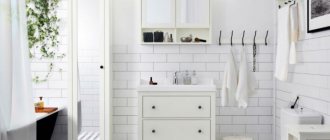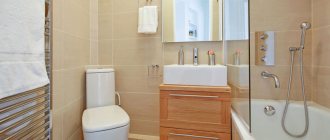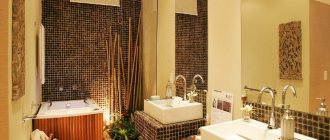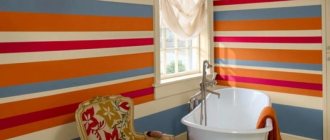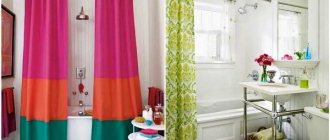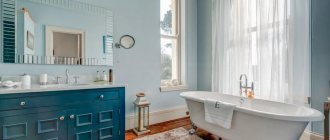The bathroom is a room with a rather specific climate, as there is constantly high humidity and significant temperature changes. Therefore, when choosing building materials for the renovation of a given room, you should pay special attention to the resistance of the materials to adverse conditions, this also applies to paints.
Of all types of building materials, paint is the most affordable option, especially if all repair work is done with your own hands.
Characteristics of waterproof paint
Manufacturers try not to include harmful chemicals in paints. Dyes contain polymer compounds and some auxiliary components.
Moisture-resistant paints have the following properties:
- They do not dry quickly, at least 20 hours;
- Some types of paints are resistant to ultraviolet rays;
- Do not fade in the sun;
- They withstand various environmental influences, so they can be used for external painting;
- Some dyes have antifungal protection.
Is it advisable to paint everything?
Of course not. For example, glass is not painted with all compounds. It is more profitable and more aesthetically pleasing to provide inserts made of frosted, colored and other types of opaque glass (including acrylic). These glasses look very modern. Moreover, glass inserts can be combined, modified, and replaced.
Painting concrete is also rarely done, since concrete can be easily plastered with decorative compounds. As the original surface, concrete remains mainly in basements and cellars. In addition, due to the porosity of concrete, paint consumption increases.
There is practically no point in painting plastic and tiles. Painted plastic looks much worse, since only painting with thick paints can avoid streaks. When painting plastic, you have to increase the layer of coloring composition, and its durability on plastic will in many cases be minimal due to low adhesion. If the need for painting is great, then the plastic should be treated with emery cloth before painting.
Plywood (as an element of arrangement of covered balconies and loggias) can also be painted. Plywood is processed in the same way as wood. Since plywood often serves as a substrate for floors made of wood, laminate, etc., it is enough to paint it in one layer.
It is better not to paint wood (in particular, parquet) at all, but to varnish it. Well-dried wood is not prone to rotting, so it is easier to extend the service life of wood coatings using less drastic methods. In addition, old paint from wood is quite difficult to remove.
Pros and cons of waterproof paint
Moisture-resistant paints have a number of advantages:
- Wide range of colors;
- Eco-friendly;
- Perfectly masks small defects on walls;
- Easy to apply to any surface;
- Do not deteriorate in aggressive environments;
- The coating is hygienic.
Dyes also have some minor disadvantages:
- Before coating, the walls must be leveled, since large defects will not disappear;
- Condensation may appear because the substance has low vapor permeability;
- Walls can only be painted at positive temperatures above 5 degrees.
Selecting a shade
When the choice of bath paint is made, you can decide on the shade of the composition. Most hardware stores have machines that can create the desired tone. If you wish, you can create the color yourself. To do this, bath paint must be mixed with a color of a certain tone.
The choice can be made depending on the size of the room. For example, small bathrooms should be painted in light shades. Such walls will fit perfectly into the overall interior. For larger rooms, various experimental options can be chosen. It’s great if the walls are painted in contrast. However, the location of household appliances and hot tubs should also be taken into account.
Advice! It should be remembered that water is better visible against a dark background.
Many apartment owners do not understand which surface to choose - glossy or matte. However, such a decision can significantly affect the overall appearance of the room. The gloss shines beautifully, but can only be chosen in the case of very smooth walls. Matte surfaces turn out to be more versatile. Under them you can hide various imperfections of the walls. At the same time, matte paints are more easily damaged by an accidental blow.
Suitable paints for the bathroom
Types of bathroom paints must have the following characteristics: resistance to moisture, safety, so that mold and mildew do not form due to dampness.
The most common are dyes with micropolymer compounds diluted with water. The cost of such paints is low.
In fact, water-based bath paints can be divided into:
- Oily;
- Silicone;
- Acrylic;
- Silicate;
- Alkyd;
- Chlorinated rubber.
The most expensive are silicone dyes; they have high quality characteristics. Acrylic and silicone paints are great for bathroom walls. They form a protective film on the surface and prevent moisture from accumulating and fungus developing. The paints contain no harmful substances to the human body, they are not poisonous, and dry quickly.
Tool for the job
Tools for painting can be brushes, rollers, or spray guns. If the area is large, then using a spray gun is advisable; in other cases, its cost is not justified. You need to dilute the paint for the spray gun to a more liquid state.
Brushes are necessary for treating hard-to-reach areas; rollers will allow you to paint the ceiling without using a stepladder. There are paints in spray cans, but they have a small volume, so they are only suitable for small jobs, for example, what you can use to paint an acrylic bathtub.
Brushes are necessary for treating hard-to-reach areas; rollers will allow you to paint the ceiling without using a stepladder.
What to putty on
Two types of putty solutions are suitable for the bathroom: water-resistant cement and polymer moisture-resistant. The use of gypsum is not recommended; they are destroyed by exposure to even a little moisture.
Two types of putty solutions are suitable for the bathroom: water-resistant cement and polymer moisture-resistant.
How to plaster
Plastering agents are also selected with water and heat resistance properties. An economical option would be cement types, which are also suitable for laying tiles on the surface.
An economical option would be cement types, which are also suitable for laying tiles on the surface.
How to level
If the walls are very uneven, then profile strips are erected to eliminate deviations. You can also use plasterboard sheets, but they must be of a moisture-resistant type, or additionally protected from exposure to water.
You can also use plasterboard sheets, but they must be of a moisture-resistant type.
Characteristics of oil paint
This is the cheapest option for painting surfaces. It is created on the basis of synthetic oils or drying oil.
The insolubility of mineral particles requires the paint to be thoroughly mixed before use.
The advantages include:
- You can paint on wood and metal;
- Does not allow moisture to pass through;
- The result is a smooth surface;
- Good adhesiveness.
There are more disadvantages:
- Strong smell before drying, takes a long time to dry (24 hours);
- The fumes are harmful;
- The color changes over time;
- It fades from the sun's rays;
- In places where water gets in, it begins to crack and peel.
This coating will have to be renewed every year, so it is not recommended to use oil paint in the bathroom.
Preparing for coloring
Before painting, certain preparatory measures should be carried out. They are very important. Even latex compositions for the bathroom cannot hide various unevenness of the walls. Because of this, the finishing process becomes significantly more complicated.
The procedure is divided into several stages:
- First, the old coating is removed. For this purpose you need to have a grinder and a flexible disk. Solvents, a sander, and a scraper are used as additional tools.
- You can remove dust with warm water.
- All wall defects that are found are covered with acrylic-based putty.
- If fungus is detected, the wall is treated with bleach.
- After preparation, the wall is treated with a primer. It is usually applied in 2 layers.
Each stage of preparation requires certain attention, so the instructions must be followed strictly.
Silicone water emulsion
The paint is odorless and easy to work with. It has its own positive characteristics:
- Fits well on any surface, even stone and concrete;
- A perfectly flat surface is not needed; it can hide some unevenness;
- Can be used at any temperature;
- The paint layer retains water but allows air to pass through, so it can be called breathable;
- Fungi and mold do not form;
- Easy to clean;
- Not afraid of sunlight.
Minus the cost, expensive paint. But this is compensated by the service life (25 years). It is better not to apply it to a metal base, as the vapors activate the formation of rust.
DIY painting instructions
Let's assume that we have already chosen the paint. All that remains is to prepare a simple tool:
- roller (fur or foam);
- several brushes of different widths with securely fastened bristles;
- masking tape - to protect surfaces not intended for painting;
- a cuvette that saves paint and allows you to remove excess material;
- spatula - for occasional cleaning.
A spatula will not be needed if the walls are initially ready to be painted. This means that they must be plastered, perfectly smooth, without traces of old paint or glue, without cracks or depressions
It is better to remove shelves, mirrors, hangers, hooks and other devices from the walls that interfere with the uniform application of paint.
Some experts insist on observing the temperature regime. Optimal indicators are from +10ºС to +20ºС. It is also important to adjust the humidity, which should be within 50-70%.
To increase this indicator in winter, use humidifiers, and if they are not available, use buckets of hot water.
Procedure:
- Prime the clean surface with a special solution. There are many types of universal-type interior primers, but it is better to choose one labeled “for paint.”
- After the primer has completely dried, we begin to apply paint with a brush in the corners, starting from the light source (window or wall lamp). We also use a brush to paint skirting boards, narrow parts, and interior elements (for example, panels).
- We paint wide surfaces last, using a roller. To ensure quality work, follow the movements - from top to bottom, then from left to right, then from top to bottom again. The technique is quite simple.
Don’t forget about the subtleties of painting: remove excess paint on a ditch or a special mesh so that there are no streaks or smudges.
To achieve a rich color, you will need to apply 2-3 layers of paint, each subsequent repetition should be done after the previous layer has completely dried
Drying time is indicated in the instructions: from 3 to 6 hours. Usually the first layer dries 2-3 hours before the rest.
Some tips from professionals - representatives of Tikkurila:
Water-based acrylate paint
If we talk about which bathroom paint is better, then it is acrylic. It has the most optimal properties:
- Slightly perceptible odor when drying, and then disappears completely;
- Resistant to moisture;
- Possesses vapor permeability;
- Adheses well to the surface;
- Can be used at any temperature, suitable even for a bath;
- Does not fade, is not afraid of UV rays;
- Eco-friendly.
A wide range of paint colors retains brightness for a long time.
The disadvantage is that the paint takes a long time to dry and the walls need to be prepared for painting. If you choose acrylic paint, then you need to know that when changing paint you will have to completely remove the applied acrylic layer.
Some disadvantages of modern paints and varnishes
Oil or alkyd compositions certainly have better adhesion (adhesion to the surface) compared to others, but after their use, long-term ventilation of the room is required. At the same time, water-dispersion paints have no odor, dry quickly and can be washed and repainted several times. However, surfaces treated with such materials should be constantly wiped until dry in order to avoid the appearance of water condensation. When it dries, it can partially wash off the coating itself.
Professional decorators recommend: when painting a bathroom, you should not use the same paint over the entire area. For the best combination, it is preferable to paint the top of the walls with water-based emulsion, and use rubber, silicones or acrylics below.
Characteristics of latex paint
Latex comes from the sap of rubber, which dissolves in water. When dry, a film appears that does not allow water to pass through. Pros:
- Quick-drying composition;
- Without smell;
- Easy to apply and clean;
- Durable.
Important: Good coloring is achieved by applying two layers.
There are also disadvantages:
- Before painting, you need to putty the walls with an even layer;
- Suitable for rooms with temperatures above 10 degrees Celsius;
- Requires additional antifungal coating;
- High price.
Although the paint is expensive, it costs little, and the silky shine on the walls lasts a long time.
How best to paint the walls in the bathroom: design in different styles
If you decide in advance on the style of the bathroom, choosing the appropriate color scheme and paint texture will be quite simple. Below you can find the most popular bathroom and toilet styles.
- Classic style. In this case, designers recommend giving preference to a combination of painted walls with ceramic tiles. When choosing a color, you should give preference to calm shades.
- High tech. The walls are painted in a gray or blue palette, and elements of bright colors and large mirrors are added to the interior.
- Provence. Designers recommend finishing surfaces with matte textured blue/pink/pistachio paint. A light yellow palette would also be a good choice. You can apply floral designs.
Every year there are more and more rooms decorated in retro style. If you want to make your bathroom exclusive, you can paint the walls with bright colors and put on them images of celebrities from the 50s, 70s or geometric patterns.
Alpina is a popular brand of paint manufacturer
Alkyd paint
This type is used for any work, but the dye has a strong smell because it contains white spirit.
The advantages of such enamel are that it:
- Resistant to aggressive environments;
- Does not change color;
- Highly durable;
- Dries quickly;
- Withstands any temperature.
Main disadvantages:
- Toxicity and odor;
- Does not allow vapor or air to pass through;
- Requires pre-treatment of walls with an antifungal compound.
If this paint is used in the bathroom, then care should be taken to have a good ventilation system. You need to choose imported products, they do not smell as strong and are less harmful.
Each of the options is suitable for painting bathroom walls. But you need to know that in places near water you should choose paint products that are breathable and moisture-resistant. This is of great importance for interior decoration.
Reviews
User reviews can help you determine which odorless bathroom paint to choose. For example, the paint “Dulux Dazzling White” for the kitchen and bathroom is characterized by users as follows:
- Olga. The paint quality is good. Dries quickly, there is almost no smell. The ceiling in the kitchen needed to be painted. I chose this brand intuitively because I heard flattering reviews about it. To paint the walls, I added color. The paint color is really white, even snow white. If you paint a large area at once, the smell is noticeable, but quickly dissipates. I used a roller for the job - painting the ceiling was convenient and quick. The only drawback of the paint is that it is too expensive.
- Alexandra. I was choosing paint for the interior decoration of a country house. I bought the paint on the advice of friends. The store was confused by the high price. But the seller praised the paint from all sides, so I chose it. Now I know for sure - I didn’t make a mistake. The color is somewhat silky, and the ceiling is easy to clean.
- Eugene. We were renovating the kitchen, so I decided to choose white paint color. I thought about taking such a composition so as not to update it for several years. I chose Dulux Dazzling White. I was surprised how thick the paint is. Lays down smoothly and has almost no odor. And it dries very quickly. The only thing that was a little disappointing was that the price was a bit high.
As you can see, reviews about this product are more often positive. This is explained by the high demands placed on modern paints and varnishes.
Recommended Posts
How to paint walls with water-based paint without streaks
Quick-drying floor paint
Mixing colors
Decoding paint markings
Wood varnish for exterior use
Paint for painting on walls


